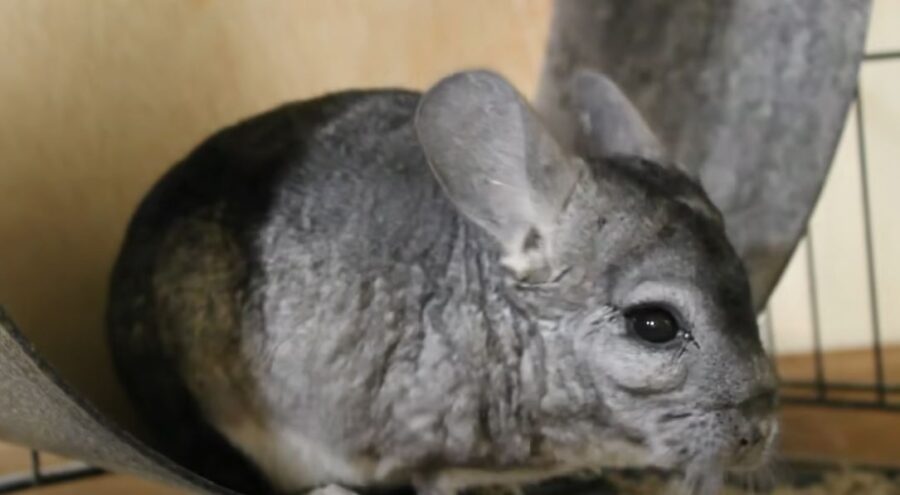Is your chinchilla getting too hot or too cold? What Is the Ideal Temperature for a Chinchilla?
How can you cool down a chinchilla? This is an important article to help you prevent your chinchilla from hypothermia or overheating.
Let’s find out right now, the ideal temperature for a chinchilla.
What Is the Ideal Temperature for a Chinchilla?
Chinchillas do not enjoy warm climates. The ideal temperature for a chinchilla is between 60°F-75°F. This is because their fur coats are dense. Humidity is also not tolerated by chinchillas. Keep the humidity down to less than 60%.
Placing their cage in a cool, dry area with enough ventilation will make sure that your chinchilla is comfortable. An air conditioner with a vent that is not pointed directly at your chinchilla is best, but you can also use other methods such as a cool pack, chin chillers or ice.

What Temperature Is Too Cold for a Chinchilla?
Although chinchillas enjoy cooler temperatures, if the temperature falls below 50°F for too long, they can become stressed. Hypothermia or respiratory problems can develop.
Hypothermia is not easily treated if your chinchilla has contracted it. You will have to visit the veterinarian with the hope that they can help save your chinchilla’s life.
How Do I Know if My Chinchilla Is Too Hot?
You will know if your chinchilla is too hot if their ears are warm and red. What is happening is that their blood vessels in their ears are swelling up and you are noticing them turning red overall.
This is the easiest and most obvious indicator that a chinchilla is overheating. The next time you see red ears on your chinchilla, know that the environment is too hot and do what you can to place them in a ventilated area that is cooler and more dry.
What Temp Do Chinchillas Overheat?
A chinchilla can easily overheat when the changes in the environment dictate temperatures to increase over 80°F or 27° C. You may notice your chinchilla developing hot or red ears at this time.
Their fur coat is to dense for them to handle warmer temperatures. They can develop many different complications such as overheating which can lead to respiratory issues that prove to be fatal for many chinchillas overall.
Do Chinchillas Need Light at Night?
No. Chinchillas see very well in the dark and do not need light. Chinchillas are not necessarily nocturnal animals but they do remain active during the dark.
They have a successful time adapting to nocturnal lifestyles, but they are crepuscular in the wild and do not require light at night.
If your chinchilla is in a well-lit area at night, they may feel vulnerable and exposed to multiple perceived predators who could be lurking nearby.
They would rather hide in the dark than be willing to expose themselves to light when it is dark outside. We should try to mimic the same situation and not expose them to light at night.

Should I Cover My Chinchillas Cage at Night?
No. It is not necessary to cover your chinchilla’s cage at night. The sounds and lights will not stress your chinchilla as much as the covering of the cage will create overheating issues.
Just make sure to quiet down a little at night and do not shine a light directly at their cage. Cage covers are useful if there are too many noises and spotlights that you cannot control.
Also, when you are traveling and there are cold temperatures during transport, covering the until the cage may prove to be helpful. Overall chinchillas will overheat in their normal environment if you cover their cage often at night.
Can Chinchillas Have Ice Cubes?
A chinchilla should not be eating ice cubes, but they can nibble on them a little. What you can do is place a bowl near their cage and put a bunch of ice cubes inside it.
Place it near the cage and point a fan in their direction to provide enough cooling that gives your chinchilla a comfortable feeling if the temperatures are too hot and there is no air conditioner working at this time.
Will a Fan Cool a Chinchilla?
Do chinchillas sweat? Your chinchilla does not need a fan to be running all night. Blowing air directly at your chinchilla cannot cool them down. This is because a chinchilla doesn’t sweat. They are dry animals.
The fan is only stirring the same air around that is still be warm and humid. The fan is mixing the ambient temperature and not actually providing any extra coolness.
You will have to adjust the temperature in the house by using an air conditioning unit or cool packs. You can also try to use a bowl of ice with a fan pointing it at it to provide cooler air towards your chinchilla’s cage.

Do Chinchillas Need Air Conditioning?
Yes. Since chinchillas enjoy temperatures that are slightly cooler than what we are used to, you would need to employ the use of an air conditioner or another type of cooling system.
If the temperature is routinely going above 24°C or 75°F when you are out of the house when the air conditioner is not on, your chinchilla might overheat.
This ball of fur is so dense that a chinchilla will develop respiratory issues that could prove to be fatal when they get too hot.
How Do You Keep a Chinchilla Cool Without Air Conditioning?
If you do not have an air conditioner on at the time when your chinchilla is feeling hot, you can use a frozen water bottle covered in fleece with a granite tile.
You can also hold your chinchilla in front of an open fridge for a little while to help cool them down really quickly. They can also lie on cool surfaces such as ice packs with a towel on top to give them temporary cooldown effects.
Do not use any type of spray or mist to cool down a chinchilla who does not wish to be wet. Wetness can develop bacterial infections on their skin.
Signs Of An Overheated Chinchilla
If a chinchilla is overheating, you need to check for the following signs to make sure they do not develop heat stroke or other types of respiratory issues that could prove to be fatal.
Your chinchilla might be:
- lethargic
- have red ears
- drooling
- breathing rapidly
1. Lethargy
One of the first signs that a chinchilla is overheating is lethargy. It is a serious symptom when a normally curious and active animal stops moving altogether. They may also not eat any food or drink water.
2. Ears Turning Red
Red ears is a common symptom of an exhausted and heatstroked chinchilla. The blood vessels are swelling inside their ears and it is easy for you to tell if they are overheating when you touch them and feel the excessive warmth.
3. Drooling
A chinchilla that is overheating may begin to drool all over itself. You can notice to drool falling to the bottom of the cage as well.
This is a kind of heatstroke you may also see that your chinchillas’ fur is becoming wet under the chin or the chest area.
4. Rapid breathing patterns
Breathing rapidly is another sign of a chinchilla getting way too hot. If their breathing patterns are changing, their hearts are beating faster.
They are trying to pant to cool themselves down. This is an early sign that your chinchilla might be overheating.

Do Chinchillas Need a Blanket?
No. Chinchillas do not require blankets. If you notice a chinchilla’s bedding underneath them, they are not usually bundling them up or making nest out of them. This is not the normal action of a chinchilla.
They are already carrying blankets all over them with their dense, thick fur. Providing them with a blanket will not give him any extra warmth. A chinchilla is a cooler and dry animal that prefers to be without a blanket instead.
How To Cool Down A Chinchilla
A chinchilla needs to be kept cool in order to prevent exhaustion, respiratory problems, overheating and potentially fatal reactions need them to be in cool dry environment.
Here are some methods to help cooldown a chinchilla:
1. Chin Chiller
Have you ever heard of a chin chiller? This is like a pocket that helps to provide a cooling effect in case of emergency. You place your chinchilla inside with a cool tile in the fleece sleeve.
2. Open the Fridge
Only used in the case of an emergency. Supervisor your chinchilla during this time. Put your chinchilla on a shelf in the fridge with the door open for only a minute or two just to get them to cool down.
This is a risky task, but will prove effective if a chinchilla is breathing rapidly, overheating and has really warm or red ears.
3. Small Ice Cubes
Your chinchilla can also benefit from small ice cubes. They can lick or chew some of them. Melting ice cubes are a problem though because then your chinchilla can get wet and this is not recommend. Bacterial infections that can result from when water settles on their dense fur and skin.
A chinchilla that is getting too cold may develop respiratory issues, pneumonia, hypothermia and plenty of other sicknesses if the temperature falls below 55°F and stays there for long periods of time.
Can Chinchillas Be Kept Outside?
We do not recommend keeping your chinchilla outside. There are too many elements that we have to protect our chinchillas from.
Gusts of wind or the potential for predators capturing the scent of your chinchilla are all risks that we do not wish to take. The sun can also be harsh.
Your chinchilla could be uncomfortable without knowing. They are also harmful plants or seeds out in this habitat that your chinchilla might be curious enough to lick or ingest.
Chinchillas should not be kept near open ventilation, windows or doors as well. The indoor environment should be cool and dry.
Thank you for visiting PocketPetCentral.com for the best information to help you enjoy the life of your pocket pet companion in a fun, safe & healthy way.


